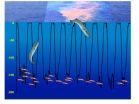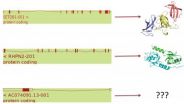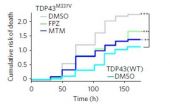(Press-News.org) This news release is available in German and French.
In Switzerland, between 7000 and 8000 persons fall ill with a campylobacter infection annually. This makes it the most frequent bacterial disease transmitted through food. Contamination of chicken meat with campylobacter bacteria during the slaughtering process is one of the known causes of the infection. An increase of campylobacteriosis case numbers is being observed throughout Europe. Human cases of campylobacteriosis must be reported to the relevant authorities in Switzerland.
In Switzerland, an unusual increase in campylobacteriosis case numbers can be observed in the period around Christmas and New Year. Therefore, the Swiss Federal Office of Public Health, in agreement with the Swiss Federal Food Safety and Veterinary Office has commissioned Swiss TPH to perform a case control study in order to investigate this increase over the festive season.
«We are relying on data subject to reporting and telephone interviews with affected persons for this», study leader Daniel Mäusezahl of Swiss TPH says.
The researchers interviewed affected persons who had fallen ill with a campylobacter infection between December 2012 and February 2013. An independent laboratory examination had confirmed a campylobacter infection in all interviewed persons. The focus of the interviews was on risk factors, the consultation of a doctor and the course of the illness experienced by the affected persons.
Fourfold increased risk when consuming a meat fondue
The study identified two factors for an increased risk of infection with campylobacter pathogens. On the one hand, the risk of infection increased by a factor of four when consuming Fondue chinoise. About half of the notified campylobacteriosis cases over the Christmas and New Year period can be attributed to this source of infection.
The study also shows that the risk of infection can be decreased by hygienic measures at the table. As soon as the meat fondue consumers used compartmented or separate plates for raw and cooked meat, the risk of an infection decreased by a factor of up to five. Likewise, the risk of an infection decreased when consuming meat that had been previously frozen. «Campylobacter infections among consumers could be avoided to a large extent by employing the appropriate hygiene behaviour measures», Daniel Mäusezahl says.
Another risk factor for a campylobacter infection identified by the study was travelling abroad over the Christmas season. However, persons returning from a trip with diarrhoea are tested more frequently for infection which might also explain this increased finding.
No harmless illness
Campylobacter infections are experienced as a severe illness by affected persons. On a scale from 1 «harmless» to 10 «very severe», half of the patients had rated the subjectively experienced symptoms with 8 or more points. Persons who have fallen ill primarily complained of diarrhoea (98%), abdominal pain (81%), fever (66%), nausea (44%) and vomiting (34%). The patients stated an average duration of illness of seven days; about 15% were hospitalised.
Worldwide problem
The contamination of chicken meat with campylobacter bacteria is a worldwide problem in the poultry industry with consequences for public health. In some European countries and in the USA, poultry meat from infected flocks is therefore only sold frozen or after being treated, e.g. with peroxyacetic acid. Microbiologists are also discussing the preventive use of bacterial viruses (so-called phages) as a possible measure to combat the illness. With this method, campylobacter pathogens can be fought biologically and the risk of infection for humans can also be decreased.
INFORMATION:
More about the results of the study in the European Journal of Epidemiology
More information about campylobacteriosis at: http://www.bag.admin.ch/themen/medizin/00682/00684/01020/index.html?lang=de
http://www.blv.admin.ch/themen/02794/02829/02847/index.html?lang=de
back to list
Original study
Philipp J. Bless, Claudia Schmutz, Kathrin Suter, Marianne Jost, Jan Hattendorf, Mirjam Mäusezahl-Feuz, Daniel Mäusezahl. A tradition and an epidemic: Determinants of the campylobacteriosis winter peak in Switzerland. European Journal of Epidemiology, DOI: 10.1007/s10654-014-9917-0
Contact address
Dr. Daniel Mäusezahl, Swiss Tropical and Public Health Institute daniel.maeusezahl@unibas.ch, phone +41 61 284 81 78
Dr. Christian Heuss, Communications, Swiss Tropical and Public Health Institutechristian.heuss@unibas.ch, phone +41 61 284 86 83
Hot Pot with chicken causes campylobacter infections in Switzerland
Simple measures help to prevent campylobacter an infection
2014-07-03
ELSE PRESS RELEASES FROM THIS DATE:
Low brain protein levels associated with neurodegeneration
2014-07-03
Persons with reduced levels of the TREM2 protein could be at greater risk of developing neurodegenerative diseases such as Alzheimer's disease or frontotemporal dementia, according to an international study which included the participation of the Universitat Autònoma de Barcelona and the Sant Pau Biomedical Research Institute (IIB Sant Pau).
The study, published in Science Translational Medicine, reveals the molecular mechanism by which the mutated forms of this protein prevent the amyloid waste cleaning process from functioning correctly and detects a lower level of ...
Whales as ecosystem engineers
2014-07-03
"Consider the subtleness of the sea; how its most dreaded creatures glide under water, unapparent for the most part," wrote Herman Melville in Moby Dick. Today, we no longer dread whales, but their subtlety remains. "For a long time, whales have been considered too rare to make much of a difference in the oceans," notes University of Vermont conservation biologist Joe Roman. That was a mistake.
In a new paper, Roman and a team of biologists have tallied several decades of research on whales from around the world; it shows that whales, in fact, make a huge difference—they ...
No two lark sparrows are alike (at least when it comes to migration habits)
2014-07-03
A new paper by Dr. Jeremy Ross from the University of Oklahoma describes the use of tiny devices strapped to birds' backs called geolocators, which capture the individual migration routes of lark sparrows in North America. By sensing the light levels, these backpacks can pinpoint the location of a bird anywhere in the world, even if retrieving the data-logger can sometimes pose a major problem.
This study, published in the online journal Animal Migration, mapped for the first time the routes traveled by three lark sparrows after they left their breeding grounds in Ohio. ...
Consider water use in climate change policies, advise Australian researchers
2014-07-03
There's more to trying to slow down climate change than just cutting greenhouse gas emissions. Technology, policies or plans that aim to do so should also take environmental factors such as water usage into account. A more integrated approach might make some options considerably more attractive than others, especially when implemented in arid countries such as Australia, advise Philip Wallis of Monash University in Australia and colleagues, in an article in Springer's journal Climatic Change.
The researchers considered the example of Australia to show how water usage ...
Jump to it! A frog's leaping style depends on the environment
2014-07-03
VIDEO:
Tree frogs reach great heights with their jumps, but do not cover much distance.
Click here for more information.
A frog's jump is not as simple as it seems....Australian scientists have discovered that different species adopt different jumping styles depending on their environment.
Lead researcher, Miss Marta Vidal-Garcia ( PhD candidate, Australian National University ), found that tree dwelling frogs reached great heights but didn't cover much distance with their ...
Study finds higher risk for celiac disease in some children
2014-07-03
AURORA, Colo. (July 3, 2014) – Physicians from the University of Colorado School of Medicine in collaboration with an international team of researchers have demonstrated that screening of genetically susceptible infants can lead to the diagnosis of celiac disease at a very early age.
The collaborative group studied 6,403 children with specific genetic markers from birth to identify the factors involved in the development of both celiac disease and type 1 diabetes. The children are from the United States, Finland, Germany and Sweden and are part of The Environmental Determinants ...
Biological signal processing: Body cells -- instrumentalists in a symphony orchestra
2014-07-03
Every organism has one aim: to survive. Its body cells all work in concert to keep it alive. They do so through finely tuned means of communication. Together with cooperation partners from Berlin and Cambridge, scientists at the Luxembourg Centre for Systems Biomedicine (LCSB) of the University of Luxembourg have now successfully revealed for the first time the laws by which cells translate signals from their surroundings into internal signals. Like an isolated note in a symphony orchestra, an isolated signal in the cell is of subordinate importance. "What is important ...
A CNIO team reduces the size of the human genome to 19,000 genes
2014-07-03
How nutrients are metabolised and how neurons communicate in the brain are just some of the messages coded by the 3 billion letters that make up the human genome. The detection and characterisation of the genes present in this mass of information is a complex task that has been a source of ongoing debate since the first systematic attempts by the Human Genome Project more than ten years ago.
A study led by Alfonso Valencia, Vice-Director of Basic Research at the Spanish National Cancer Research Centre (CNIO) and head of the Structural Computational Biology Group, and ...
Could boosting brain cells' appetites fight disease? New research shows promise
2014-07-03
ANN ARBOR, Mich. — Deep inside the brains of people with dementia and Lou Gehrig's disease, globs of abnormal protein gum up the inner workings of brain cells – dooming them to an early death.
But boosting those cells' natural ability to clean up those clogs might hold the key to better treatment for such conditions.
That's the key finding of new research from a University of Michigan Medical School physician scientist and his colleagues in California and the United Kingdom. They reported their latest findings this week in the journal Nature Chemical Biology.
Though ...
Ironing out details of the carbon cycle
2014-07-03
Iron is present in tiny concentrations in seawater. On the order of a few billionths of a gram in a liter.
"I did a calculation once on a ton of ocean water," says Seth John, an assistant professor in the department of marine science at the University of South Carolina. "The amount of iron in that ton of water would weigh about as much as a single eyelash."
Given that there is so little iron in seawater, one might conclude that its presence there is inconsequential.
Hardly. Iron is one of the essential elements of life. Found in enzymes like myoglobin and hemoglobin ...
LAST 30 PRESS RELEASES:
Scalable and healable gradient textiles for multi‑scenario radiative cooling via bicomponent blow spinning
Research shows informed traders never let a good climate crisis go to waste
Intelligent XGBoost framework enhances asphalt pavement skid resistance assessment
Dual-function biomaterials for postoperative osteosarcoma: Tumor suppression and bone regeneration
New framework reveals where transport emissions concentrate in Singapore
NTP-enhanced lattice oxygen activation in Ce-Co catalysts for low-temperature soot combustion
Synergistic interface engineering in Cu-Zn-Ce catalysts for efficient CO2 hydrogenation to methanol
COVID-19 leaves a lasting mark on the human brain
Scientists use ultrasound to soften and treat cancer tumors without damaging healthy tissue
Community swimming program for Black youth boosts skills, sense of belonging, study finds
Specific depressive symptoms in midlife linked to increased dementia risk
An ‘illuminating’ design sheds light on cholesterol
Who is more likely to get long COVID?
Study showcases resilience and rapid growth of “living rocks”
Naval Research Lab diver earns Office of Naval Research 2025 Sailor of the Year
New Mayo-led study establishes practical definition for rapidly progressive dementia
Fossil fuel industry’s “climate false solutions” reinforce its power and aggravate environmental injustice
Researchers reveal bias in a widely used measure of algorithm performance
Alcohol causes cancer. A study from IOCB Prague confirms damage to DNA and shows how cells defend against it
Hidden viruses in wastewater treatment may shape public health risks, study finds
Unlock the power of nature: how biomass can transform climate mitigation
Biochar reshapes hidden soil microbes that capture carbon dioxide in farmland
Reducing saturated fat intake shows mortality benefit, but only in high-risk individuals
Manta rays create mobile ecosystems, study finds
Study: Mixed results in using lipoic acid to treat progressive multiple sclerosis
Norbert Holtkamp appointed director of Fermi National Accelerator Laboratory
New agentic AI platform accelerates advanced optics design
Biologists discover neurons use physical signals — not electricity — to stabilize communication
Researchers discover that a hormone can access the brain by hitchhiking
University of Oklahoma researcher awarded funding to pursue AI-powered material design
[Press-News.org] Hot Pot with chicken causes campylobacter infections in SwitzerlandSimple measures help to prevent campylobacter an infection




